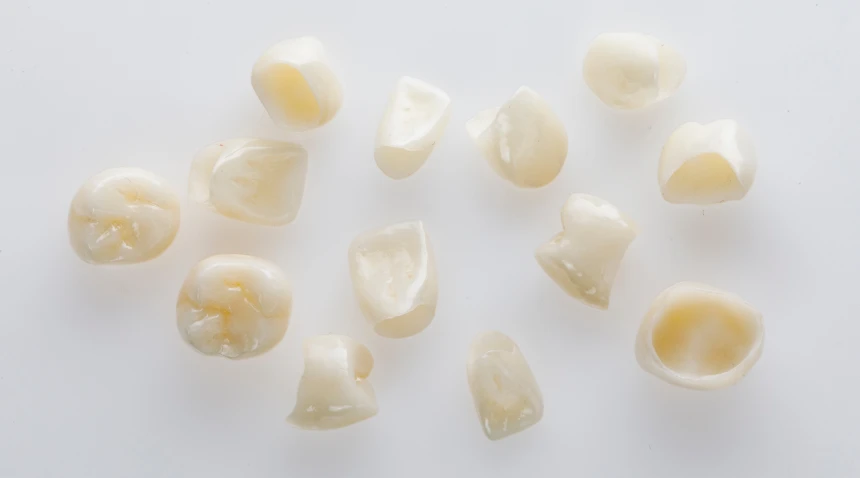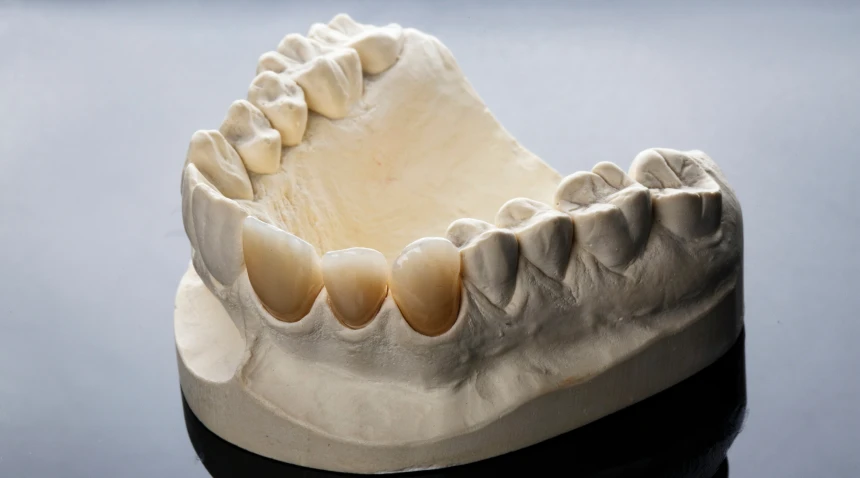Ceramic crowns are prosthetic restorations used to fully cover and protect a weakened tooth. They offer a long-lasting and discreet solution to restore the shape, function, and appearance of a damaged tooth.
Thanks to their ceramic composition, they faithfully replicate the look of natural enamel, allowing the crown to blend seamlessly with the surrounding teeth for a harmonious smile.

By fully covering the tooth, the crown provides optimal protection for the remaining structure and helps maintain proper chewing function. This type of restoration is generally recommended when the tooth is too damaged to be repaired with a simple filling material such as composite.
In addition to its strength, the ceramic crown offers excellent aesthetics, allowing the tooth to regain its natural appearance.
When should a ceramic crown be placed?
Several clinical situations may indicate the need for a ceramic crown, such as:
- A tooth has suffered a fracture or significant wear.
- A deep cavity has caused major loss of dental structure.
- A root canal treatment has left the tooth more fragile.
- A dental implant requires a prosthetic restoration.
- The aesthetic appearance of a tooth needs long-term correction.

The dentist carefully analyzes each case, taking into account the condition of the tooth, its position, the patient’s expectations, and the functional requirements. This comprehensive assessment helps determine the most suitable treatment solution for each individual situation.
How Is a ceramic crown placed?
The placement of a ceramic crown involves several steps, usually spread over two or more appointments.
- Preparing the tooth
The dentist reshapes the tooth to create enough space for the future crown. This step is performed under local anesthesia to ensure the patient’s comfort. - Taking the impression
After preparation, a precise impression is made. It provides the dental laboratory with all the necessary information to craft a perfectly fitted crown. This impression may be taken using traditional materials or a digital optical scanner. - Placing a temporary crown
While the final crown is being fabricated, the dentist places a temporary crown to protect the tooth and maintain its appearance and function. - Cementing the final crown
During the following appointment, the permanent crown is tried in the mouth. If the fit and aesthetics are satisfactory, it is sealed using a biocompatible dental cement. The dentist then checks the bite alignment and the patient’s comfort before finalizing the procedure.
Thanks to this precise and meticulous protocol, the ceramic crown integrates seamlessly and provides a durable, natural result.
An aesthetic and functional result
The ceramic used for these crowns offers remarkable aesthetic qualities. Thanks to its translucency and customizable shade, it can faithfully reproduce the appearance of natural enamel. As a result, the smile remains harmonious, even when the restored tooth is in a visible area.
From a functional perspective, the crown restores the tooth’s strength and chewing ability, providing lasting comfort without discomfort.
Moreover, ceramic is a biocompatible material that is well tolerated by gum tissue. It does not cause inflammation or discoloration along the gum line.
Care and longevity
Good oral hygiene plays a key role in extending the lifespan of dental crowns. On average, a ceramic crown lasts between 10 and 15 years. In some cases, it can remain in place much longer — provided certain care habits are followed.
Here are a few recommendations:
- Brush your teeth twice a day with a soft-bristled toothbrush.
- Use dental floss or interdental brushes to clean between the teeth.
- Avoid chewing very hard or sticky foods during the first few days after the crown is placed.
- Schedule regular check-ups with your dentist, at least once a year.

By following these simple habits, you help ensure that your ceramic crowns remain strong, aesthetic, and long-lasting.
What are the alternatives?
While ceramic crowns are suitable for many situations, other treatment options may also be considered:
- Porcelain-fused-to-metal crown (PFM)
This type combines a metal base with a ceramic covering. It offers excellent mechanical strength, particularly for molars, but may sometimes cause slight aesthetic issues near the gum line due to the metal core. - Zirconia crown
Zirconia is an exceptionally strong ceramic material. It’s ideal for areas exposed to heavy chewing forces, although its natural opacity can make it slightly less aesthetic for front teeth. - Inlay / Onlay
This type of partial restoration is used when the tooth is only moderately damaged. It preserves more of the natural tooth structure compared to a full crown.
The choice of restoration depends on a careful evaluation of your dental health, functional needs, and aesthetic goals.
Frequently Asked Questions (FAQ)
- Does a ceramic crown cause pain?
No, the procedure is performed under local anesthesia. After placement, you may experience mild sensitivity, but it usually disappears quickly. - Can a crown fall off?
Yes, in some cases. If the cement loses adhesion or if the tooth suffers a shock, the crown may come loose. It’s important to consult your dentist promptly if this happens. - Can a ceramic crown be placed on a front tooth?
Yes, it’s actually a common indication. Thanks to its natural appearance, a ceramic crown blends in perfectly with visible teeth. - What maintenance is required?
Daily brushing and flossing are essential. Regular dental check-ups also help ensure that the crown remains in good condition. - How long does it take to make a crown?
Generally, it takes about two to three weeks between the impression and the final placement. This time frame may vary depending on the dental laboratory and scheduling. - Crown or veneer: what’s the difference?
A crown covers the entire tooth, while a veneer only covers the front surface. The choice depends on the extent of the tooth’s damage.
Book an appointment at Cabinet Dentaire Mirabeau
Would you like to learn more about ceramic crowns in Paris 16? The Cabinet dentaire Mirabeau team is here to guide you through every step of your treatment. Each case is carefully assessed, taking into account your individual needs and comfort.
For a consultation, you can book your appointment online today.
You may also like: Teeth Whitening